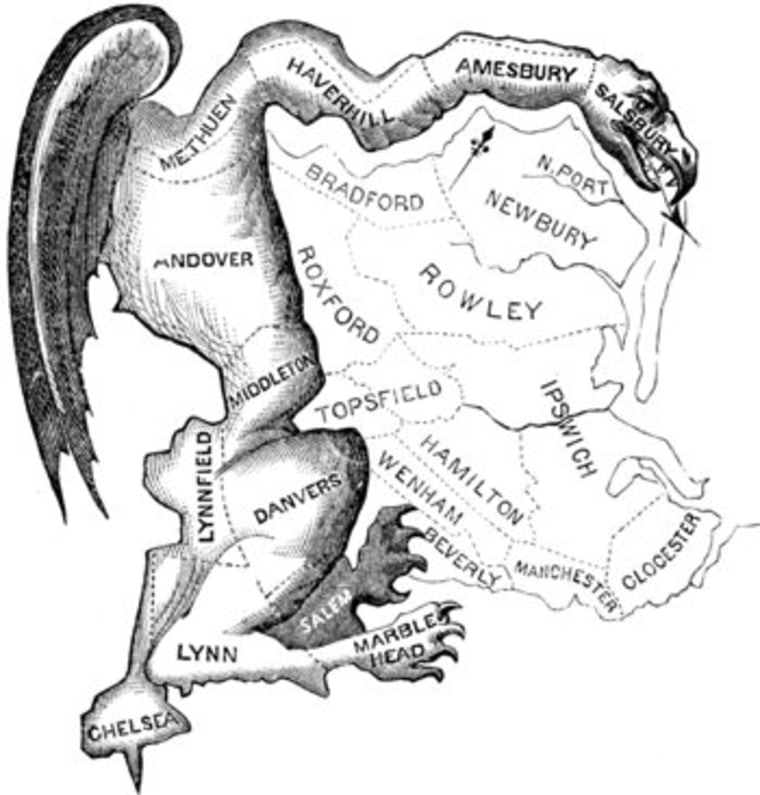"Gerrymander" is hardly the King's English. It is a word born of politics, drawing its roots from a Federalist newspaper editor who complained about Jeffersonian Republicans forcing a re-districting bill through the Massachusetts legislature in 1812 that was said to give those Republicans a political advantage. Governor Elbridge Gerry was in office at the time, and the paper's editor, seeing how the new voting district resembled a salamander, simply combined the names so as to blame the governor.
"Salamander! Call it a Gerrymander," yelled the editor, whose Boston paper published this image.
Rachel described last night how this kind of thing, nearly 200 years later, remains a common practice by American political parties in this country -- and why it is an especially big deal again now. In Arizona, Governor (and author) Jan Brewer's interference with an independent commission and removal of its chairwoman was deemed a "Scott Walker-style power-grab from hell" by the Washington Post's Greg Sargent.
If all parties had voted to oust the chairwoman, that'd be what's called a "sweetheart gerrymander," in which both parties collude to preserve their own power. But with a 21-9 advantage in the State Senate, more than the two-thirds advantage needed by Governor Brewer needed to oust the independent commission's chairwoman, who needs getting along to go along? What Arizona Republicans, the governor included, are aiming for is a "partisan gerrymander," in which the party in power angles to keep that power by simply re-jiggering the districts.
A similar battle is waging in my native Ohio this week:
Statehouse Republicans and black Democrats were at an impasse Tuesday after the black lawmakers rejected an alternative congressional map redrawing districts for Ohio's major urban cities.Rep. Sandra Williams, a black Cleveland Democrat who heads the Ohio Legislative Black Caucus, said a GOP offer to draw black voters together into districts unifying cities wasn't enough for her caucus, primarily because it didn't alter the map's 12-to-4 ratio of Republican-to-Democratic districts."Accepting a 12-to-4 map is not something we are going to do," she said. "That is unacceptable to me and other members of the black caucus."
Despite not having a deal on the new map, Republicans plan to forge ahead with a vote on the version rejected by their Black Caucus. With a nearly 60-40 majority in the state house, they can pass it. The important detail is that they're aiming to do something similar to what Governor Brewer did in Arizona: use a two-thirds vote in the House to pass it as an emergency measure. Why does that matter so much?
Ohio Republicans are seeking to avoid a sequel to their current battle over Senate Bill 5. If the new map gets passed as an emergency measure -- which requires a two-thirds vote (including seven votes from Democratics) -- there could be no ballot referendum like Tuesday's Issue 2, which will decide the fate of Governor John Kasich's union-stripping bill.
And here's the kicker: any such referendum would immediately suspend the new map, much as Senate Bill 5 has been kept from going into effect, pending Tuesday's vote. And given especially how effective Ohio Democrats have proven themselves to be in collecting signatures (and the lead in the polls for the repeal side), Republicans seeking to gerrymander Ohio would apparently prefer to wiggle out of a similar fight.
More: Citizens United is spending big for your vote to keep SB5, Ohio.
UPDATE: The Ohio House Speaker released a new map today, seeking to attract more Democrats. A vote is set for this afternoon, according to the (Cleveland) Plain Dealer.
